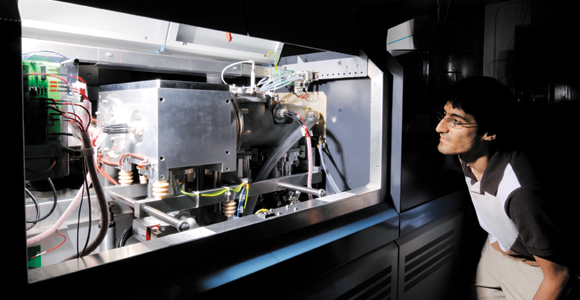Magma and the moon
By Shira Tevah, ‘09
Nicolas Dauphas, associate professor in geophysical sciences, has found a new way to reconstruct planetary origins. With the help of a plasma source mass spectrometer he analyzed isotopic variations in olivine crystals, commonly called peridot, in basalt at the Kilauea Iki crater in Hawaii. Basalt is also found on the moon, and if moon basalt formed in a process similar to that of the Kilauea Iki crater, it may provide evidence for the theory that the moon was created from Earth’s collision with another cosmic object.
Using samples drilled from the crater every few years since its last eruption in 1959, Dauphas and colleagues in Chicago’s Origins Laboratory traced subatomic changes in the crater’s magma as it cooled and hardened.The spectrometer, obtained last year with University and NASA funding, separates ions by mass. It uses argon plasma—able to ionize elements because, although microscopically neutral, it contains charged particles—to generate ions at 14,000 degrees Fahrenheit. The ions’ isotopes then separate by mass in the spectrometer’s magnetic field: ions with different radii end up in different circular trajectories.
Dauphas used the instrument—a more precise version of the first plasma source mass spectrometer produced in 1996—to measure variations in the lava’s iron isotopes. In contrast to earlier studies, which examined basalt as a whole, Dauphas’s team focused on individual minerals such as peridot, composed of several elements including iron.
 Ali Pourmand from Dauphas’s lab uses the plasma source mass spectrometer.
Ali Pourmand from Dauphas’s lab uses the plasma source mass spectrometer.
Scientists have long thought isotopes occur only at low temperatures and in light elements, but the new findings, published in the June 20 Science, indicate that isotopes can also occur at temperatures as high as 2,012 degrees Fahrenheit—and in heavy elements like iron.
“I’m interested in looking at what the constituents of matter are,” Dauphas says, “because it can tell us something about the formation of the Earth and solar system and how geological processes shaped our planet.”
